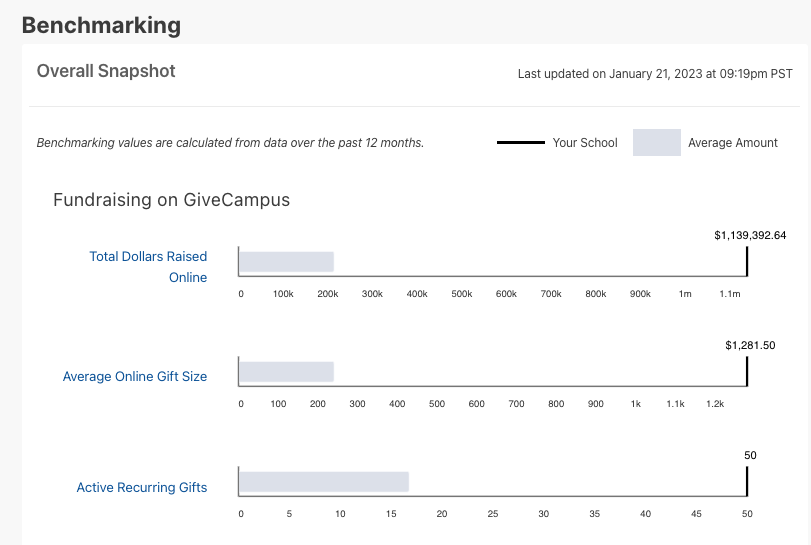How to Create SMART Fundraising Goals for Your Giving Day
Everyone wants to run a successful fundraising campaign, but the definition of success is far from universal. How you decide to measure the success of your Giving Day initiative is unique to your school and is largely impacted by your mission, vision, and history.
The amount of funds raised or the number of donors engaged might be obvious choices for measuring success. Other factors you may want to track include media mentions, social media followers, challenges, available matching funds, and volunteers engaged. You’ll likely create your goals around some or all of these metrics.
When it comes time to gauge the success of your initiative it is not enough to merely have a handful of goals. Too often, goals tend to be vague notions where determining success can be difficult. To combat potential confusion and better evaluate how a goal was reached—or where it fell short—focus on phrasing.
If a goal is SMART—specific, measurable, attainable, relevant, and timely—it will be easier to ensure that everyone on your team is clear on exactly what benchmark you are trying to meet.
Below you’ll learn how to create SMART fundraising goals around your next Giving Day. Learn how to develop clear and impactful goals, whether you want to focus on donors, funds raised, volunteer engagement, or all of the above!
Setting SMART Goals
As mentioned above, there are five key components to a SMART goal—specific, measurable, attainable, relevant, and timely. Learn more about each element and how to incorporate it into your goal in the corresponding sections below.
Specific
Naming a specific goal is the biggest funnel when it comes to focusing on what you want to achieve. Vagueness is often a problem with goal setting. Let’s say your goal is to broaden your reach. When making a statement like that, do you mean you want to increase new or one-time donors or do you want to be more visible? If you mean the former, state explicitly in your goal that you want to increase new donors or conversion rates. If you mean the latter, break that down into page views, media mentions, followers, or reposts.
By naming individual factors, you have taken one ill-defined goal and turned it into six or more specific goals. You may only really mean or care about one of those factors. Or, you may care about half or all of them. Decide with your team what elements are most relevant to your initiative and name them.
Measurable
Qualitative goals are nice, but they can be hard to measure. Words like “better,” “more,” or “higher” come to mean almost nothing when there isn’t a way to measure the outcome. Quantitative goals provide a much firmer and more distinct yardstick by which to determine success. Specific goals give you a direction, but measurable goals give you a finish line.
For your fundraising, put a number on your goals. Whether that’s a percentage increase from last year or a number to count towards, measurable goals let you know how close you are to success every step of the way. You know when you meet it and by how much you exceed it. You can gauge not only whether you are successful, but how successful you are. If you come close to your goal but don’t meet it—which is frustrating but possible—you can see how close you came rather than regarding it as an all-or-nothing situation.
Maybe your goal is to increase the average gift size by 25 percent. If it rises by 30 percent instead, then you can count the win and adjust next year’s goals accordingly. If it only increases by 23 percent, then you may not have met the goal, but you know that you came close and that your goal was within a reachable range.
Attainable
If you have set a fundraising goal that is specific and measurable, you are moving in the right direction. However, it’s possible to set a goal that meets both of those criteria but overreaches your current abilities or underestimates your potential growth.
Attainable goals need to take into account the history of your organization. If you hosted a Giving Day last year, look at those numbers to determine what would be considered reasonable growth for you. If running a Giving Day is new for you, look at past fundraising campaigns to project what might be within reach for this initiative.
Platforms like GiveCampus may also provide benchmarking data in a school’s dashboard to help schools understand how their fundraising efforts compare to similar schools. This kind of information can help you gauge what is possible so that you don’t under or overvalue your initiative’s potential.

GiveCampus also provides campaign easy-to-navigate campaign reports for your social fundraising campaigns and everyday online giving. Having all of your Giving Day metrics in the same streamlines goal setting in the future.

For your fundraising, the goal you set should be challenging without overreaching and setting yourself up to fail. If your organization has never raised more than $5,000 in one event or initiative, don’t set your Giving Day goal at $100,000. Likewise, if you’ve consistently increased the number of first-time donors by 15 percent, don’t set the bar at 10 percent.
There are no hard and fast rules about what constitutes an attainable goal. Look at your school’s previous metrics, talk with individuals in your organization, and review benchmarking data from similar schools to help make an informed decision about what is realistic for your Giving Day.
Relevant
Any goal you set for your Giving Day should be valuable to the Advancement department and your team. There’s no point tracking a particular metric if you know you won’t do anything with the information. Focus on what you need or what you use. Just as you don’t want to set a goal that seems unreasonable, you don’t want to set a goal that can be achieved with minimal effort or means nothing to your organization.
Maybe your school has a strong fundraising presence on Facebook and Instagram but doesn’t have an account on YouTube. You may want to incorporate videos into campaign awareness efforts, so this social media channel seems like a good fit.
However, there is a big difference between employing one or two powerful videos and focusing on a platform where everything would need to come in the form of a video. If your cause doesn’t naturally lend itself to a regular series of videos or if no one on your in-house team has the skills necessary for frequent video production, then it doesn’t make sense to set a goal to expand your online presence by starting a YouTube channel. A better approach may be to incorporate video into your giving campaigns directly onto your campaign page or in your stewardship journey. Tools like GC Video simplify implementing videos into your Giving Day strategy.

Timely
Keep a timeline in mind when setting your goals. When it comes to tracking your funds and activity, the Giving Day itself is the most likely time frame. While the bulk of your activity will happen on your Giving Day, your initiative neither starts nor stops there.
A soft launch or pre-launch will open your fundraising sooner but your goals don’t all have to be about the fundraising itself. If you have goals that are more important in the preparation phase— like communication and image asset design—name and use them. You will also have stewardship efforts taking place after your Giving Day. Perhaps your Stewardship Ambassador emphasizes personalized or handwritten “thank-you notes.” A possible SMART goal around your stewardship might be to write X notes per day after the close to ensure that all donors are thanked meaningfully within a predetermined timeline.
Tracking and Reporting on Goals
Once you have your SMART goals set, you’ll want to make sure you have the necessary tools and resources to track any relevant metrics. Using a platform like GiveCampus for your Giving Day simplifies the collection of many types of fundraising data.
In addition to providing seamless online gift processing, GiveCampus provides users with access to a variety of analytics and dashboards that can help them to identify trends and measure the success of their campaigns. Easily track information about donations such as dollars, average gift size, and payment type. Plus, you can generate reports on your actual donors that capture name, affiliation, recurring status, and more.

Beyond metrics around donations, it’s a good idea to track your social media posts, reach, and engagement. Note any information that relates to the goals you set for this year, as well as any that may influence your goals or strategy for next year.
The goals that you meet during your Giving Day initiative would not be possible without your donor base. It is never too early to thank your donors and begin your stewardship efforts. Real-time updates can be part of this process and can broaden your reach. Throughout the day, share updates when you reach milestones like 500 individual donors or 50 percent or 75 percent of your fundraising goal. This connects the community of your donor base and may encourage them to invite friends and family to contribute to your initiative.
You can also keep your progress current without sending an email or social media post for every update. Platforms like GiveCampus make it simple to create social fundraising campaigns that automatically update and display progress toward your Giving Day goal. Consider including a leaderboard to track total donors, top donors, or even teams. Gamifying your Giving Day may tap into some competitive spirit and inspire your constituents to donate.
Summary
Executing a Giving Day is a huge feat and something to be proud of. However, you’ll want to create goals around your initiative to measure your success and share it with your leaders and constituents. Think beyond just basic numbers like dollars raised or donors engaged. Creating SMART goals around your Giving Day helps ensure you are working towards worthwhile and definable goals.
GiveCampus can help you reach your Giving Day goals from reporting and analytics to stewardship to collecting and processing donations on your actual Giving Day. To learn more about how to leverage the full suite of GiveCampus solutions for your next Giving Day, speak with a fundraising expert.




